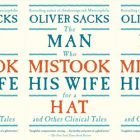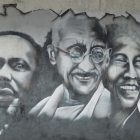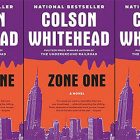Ander Monson’s Essaying

In his prize-winning debut essay collection Neck Deep and Other Predicaments (2007), Ander Monson established his writing’s hallmark: a fascination with the essay, particularly its form and form’s relationship to its content. In one essay from Neck Deep, for example, he made use of the Harvard Outline, playing with how he mines the structure while the structure comes to resemble a mine shaft in his examination of mines, a subject he returns to in later works. Another essay takes the shape of an index. Alongside and through his scrutiny of the formatting of both a page’s text and its white space, Monson repeatedly examines self, memory, and the nature of truth in nonfiction in the contexts that compel him.
These themes are just as present in Monson’s latest collection, I Will Take the Answer, set for publication tomorrow, along with his new short story collection, The Gnome: Stories. In I Will Take the Answer, Monson, who has published in several genres and serves as the editor and publisher of New Michigan Press and the literary journal DIAGRAM, continues his exploration of essays and essaying, scrutinizing the “I”—as he calls it here and in his 2010 book Vanishing Point: Not a Memoir, “the monolith,” playing with prose and white space on the page, and examining the nature of memory—all while suffusing his observations with the cultural elements he examines in earlier collections.
Like his earlier work, the essays within I Will Take the Answer are heavily predicated on place. While Monson’s previous essays focused on his Michigan (particularly Upper Peninsula) roots, I Will Take the Answer pivots to his current home, Tucson, AZ, with Michigan hovering like a specter: “It’s fair to say that my life is suspended between two poles / the wet or snowbound landscapes of Michigan that still shape the way I / think and dream and write, and the hazy desert loneliness of / Arizona, where I now live and work.” Monson still gravitates to the mines that dot the UP —“I’ve been writing about mines for as long as I remember writing,” he says—but now water conserving desert plants and the blazing sun flare in his descriptions of the arid Southwest.
From the Rillito and Santa Cruz Rivers, which mostly run dry except during monsoons when they can forcefully flood, to the Chiricahua Mountains and scenic desert highways, the landscape of the Southwest dominates the work. Peppering the essays with significant frequency are the saguaros—which, though protected, are often vandalized, resulting in the deaths of hundred-year-old cacti. Monson describes one saguaro that is shot fourteen times and others that vandals have taken machetes, saws, or axes to. “Witnessing a hackedASDFGH-up saguaro makes me want to vomit,” Monson writes in “Uncharitable Thoughts on Dokken.” “It’s a visceral, breathtaking act of vandalism, and it reminds me of the power of that kind of disfiguring…It’s no accident that the terms we use for the bodies of cacti or plants—trunk, limb, skeleton, skin—are our analogues.”
For Monson, the saguaros aren’t simply a mundane aspect of the desert. He is constantly pricked and bleeding from bougainvillea, agaves, palms, and ocotillos, but the saguaros occupy a certain place of reverence. Monson points out that their arms don’t grow until they’re over a hundred years old, yet vandals hack these arms off in one fell swoop, the saguaro’s spines unable to protect against the weapons of humans. Monson also notes that people kill the saguaros by transplanting them, their damaged roots only able to keep them alive for so long, much like the grove of trees that was poisoned and died in Monson’s former home, Tuscaloosa. In general, Monson is drawn to the dead and dying: Tucson’s unique All Souls Procession; the descansos (roadside memorials) found around the city; those who died in the Italian Hall Disaster, or Massacre of 1913, in Calumet, Michigan; and, in a sense, the mines and mining towns, like Donken, in the Upper Peninsula. The saguaros reflect the fragility of life, impermanence we forget about; they are emblematic of the senseless deaths of those unable to protect themselves.
The desecrating of the saguaros becomes analogue to another through-line Monson weaves in I Will Take the Answer: the shooting that took place at a Safeway in Tucson on January 8, 2011, when Jared Lee Loughner shot Congresswoman Gabrielle Giffords in the head and killed six other people at the scene. Monson references the shooting across the collection via mentions of Giffords, Loughner, gun control, descansos, Safeway, and various aspects of American culture. He notes the quickness with which American culture washes traumas away. “It’s amazing how resistant our culture is to showing the scars of our violence,” he observes. “It’s like we could do almost anything to a building or a place or a group of people gathered there, and a Safeway or a Walmart or a Panera or a Mattress Firm or a Starbucks would come flooding back right in within a year and there would be almost no mark at all.” One thinks of those monsoon-flooded rivers washing away bridges that will be quickly rebuilt, traumas slicked over. Monson wonders if “[p]erhaps…this living in constant ruin and reconstruction is the norm” now.
“This is in part what acts of violence do, and where they get their power,” Monson writes. These acts of violence “perforate our speech beyond our capacity for grammar,” he asserts, causing us to lose the language to speak our wounds; we’re left divvying up our lives into “before” and “after” these violences. “[W]hether you think of your life as pre-9/11 or post-Columbine,” Monson lists, “where you were when you heard about Giffords, the Challenger explosion, the Boston Marathon bombing, Sandy Hook, Pulse, Vegas, before our childhood friend’s murder and just after.” Thinking of life with this dichotomy is more than familiar—it isn’t difficult for me to think of a shooting in my life that most resembles Monson’s experience with Giffords’: Elliot Rodger’s Isla Vista killing spree in 2014, which also left six dead, took place while I was at UC Santa Barbara. The shooting happened just weeks before my college graduation. I remember the little memorials that sprang up like breadcrumbs along the path he’d taken that night; going back six years later, there was nothing left, and there hadn’t been for some time. The scars of the violence have been manicured over and are now mostly remembered through our fear of unhinged men, the crack of gunfire, or a car accelerating too fast.
That I’m compelled to filter what I read through my own experience is no surprise, as Monson points out repeatedly, just as essays are inherently filtered through the monolith “I.” “We have no option but to apprehend the world through the lens of self, the double heart of landscape we carry with us,” he asserts. Writers often address the eye/I parallel, and Monson deploys it here: the eyes through which we view the world as the I, the self, are how we shape our experience of the world toward meaning; there’s the landscape we exist in and the inner landscape of our memories and truths, shifting current though it may be. With this backdrop, we essay toward meaning—or, as David Shields articulates in his 2010 book, Reality Hunger: A Manifesto, “The essay consists of double translation: memory translates experience; essay translates memory.” Having been filtered through the I, Shields notes that “[e]ssays, unlike novels, emerge from the sensations of the self.” He also asks, “What is a fact? What’s a lie, for that matter? What, exactly, constitutes an essay or a story or a poem or even an experience?” Monson offers a similar line of question in his essay “Index for X and the Origin of Fires” from Neck Deep: “Is this stuff true? What is its truth content? What can be verified or fact-checked? What can we call it if it’s false?” The stuff in which essays trade is murky, subjective—how can one write about what one isn’t so certain one remembers? We lean into our own truths, landscapes, and private obsessions—mines, saguaros, home, sad music—and from them wrench something that, ideally, extends beyond ourselves.
With echoes of Joan Didion, Monson writes, “The stories we tell ourselves about our pasts, from which we construct self…How it’s remembered matters to the brain more than how it was…We examine, reconstruct.” He continues, “Removed from our worlds, our histories of self, the things and songs we love, our spectacles or the spectacles we have become, the outlines of our lives—that constant backward looking, searching for what we might contain, or in what we are contained—we might well disappear.” We construct our selves, constantly searching our past to find meaning. Writing the self, then, requires a triangulation of the internal and external elements that make up our world, Monson notes. Jenny Boully expresses a similar idea in The Book of Beginnings and Endings, from 2007: “In order to make art, we triangulate our thoughts from the body, to the otherworldly and then to the worldly.” The monolith and memories, the world and fact, a searching for truth, become lenses we use to construct the self. As he did in previous collections, in I Will Take the Answer, Monson probes self, truth, and memory through his own subjectivity and cultural interests, though in this collection the poles of arid Tucson and wet, green Michigan and their relative traumas and violence play a crucial role in depicting these themes; along the way, Monson never loses sight of form and its relationship to content.
Ideally, no matter how hazy of grounds the essay stands on, it is executed with craft, delivering to the reader something carefully wrought. Form matters (an aspect of narrative that Monson dwells on at length in I Will Take the Answer and in his earlier works, Vanishing Point in particular). Ruth Behar, who Shields quotes in Reality Hunger, cautions in her book The Vulnerable Observer: Anthropology That Breaks Your Heart, “Vulnerability doesn’t mean that anything personal goes. The exposure of the self who is also a spectator has to take us somewhere we would otherwise not get to. It has to be essential to the argument, not a decorative flourish, not exposure for its own sake.” The monolith, the sensations of self, the churning the self does in essaying are only successful if they yield something to the readers deeper than navel-gazing, which form must be a part of.
Although in I Will Take the Answer Monson doesn’t experiment with form as much as he does in Neck Deep, with its mining outline and narrative index, experimentation isn’t absent from this collection. In “I in River,” Monson makes the reader do work in reading the essay, while also showing them how little work is actually required. Rather than using conventional left to right reading, readers follow the prose as it meanders, like a river, across pages. In the midst of the meandering river of prose, there are prose islands. We see the possibilities, consider the margins. Though this is the most formally transgressive piece in the collection, essay lengths range, there’s an anaphora list essay (“Long Live the Jart, Heavy and Pointed and Gleaming”), and Monson makes careful use of paragraph breaking. Such choices force the reader to question their engagement with the prose and learn new ways to interact with it. And reading this collection as a whole, we’re drawn to the threads between the essays, though they might look different in each setting.
The essay, Monson declares, extends beyond the self, reaching out into collectiveness, pushing past the polarizing, dogmatic detritus our culture is mired in. “[T]he genre and its spirit provide an alternative to the dogmatic thinking that dominates much of social and political life in contemporary America,” Christy Wampole writes in “The Essayification of Everything.” For Monson, as he writes in his introduction to How We Speak to One Another: An Essay Daily Reader, “it’s not a shocker that essays, the most rhizomic of literary forms, flourish in the network—the social—age.” The I is important, but so much of the essay is collective, too. And, more importantly, it is “a resistance against the zealous closed-endedness of the rigid mind” as well as, according to Wampole, “a tendency away from certitude.”
The essay, Monson writes in I Will Take the Answer, is the “best simulation of the brain on the page we’ve got—it’s natural motion, like the river’s, is meander” and “more naturally collaborative than other literary forms.” “Talking about I is an undertaking,” he writes, “meaning talking about decay…It is talking about shame. It is talking about voice.” In Vanishing Point, Monson says that the I “can answer, be affronted by, or rebut fact-checking queries. It can be wrong. It can be shamed.” He offers an antidote to handling the shame in talking about the I by suggesting that an essay can do more than ruminate in an endless self-centered loop; instead “there are a lot of ways of giving back, of metabolizing shame, of saying thanks and maybe sorry for my ignorance. I get it now.”
In many ways, Monson’s essays feel so pedestrian—perhaps that’s why I’m charmed by them. He’s just a suburban dad living in the desert, getting all scratched up doing yard work, reminiscing about his childhood in the UP, putting up a massive Christmas display, and fixating on the violence close to home. At the same time, his essays stun because he un-perforates our sentences blistered with trauma and violence. “I’m jumping around, I know,” Monson writes in “A Five-Star Review of a Safeway,” which is primarily about the Giffords shooting. “It’s almost as if I can’t quite bear to look at this memory.” Though found in this essay, these sentences could be included elsewhere in the book, as he continues to wrestle with the shooting; ultimately, Monson chooses to look at the memory even if he jumps around, and his looking yields a critical commentary on American consumerism, gun control, trauma, and a bevy of other points. He leaves readers wondering: What violence have we slicked over? Violence forces us to reassess what is safe and what might be safe again someday. Monson asserts: “[T]he well-built, solid world we thought we had isn’t so stable.” Even the stability of the self can come under question. In its echo chamber, the self is stable, as Loughner horrifyingly reminds us. As Monson says, “[I]t girds itself against any news,…it immediately narrativizes terror in order to feel better about it, to file it safely away using whatever logic drives us.”
Reflecting back on the collection, saguaros and the Safeway and the shooting stand out most to me. Is it just as easy to shoot the saguaro as it is to shoot a person? “Long live Safeway and Starbucks and other American shrapnel,” Monson writes. Yet in the same essay there are lines filled with yearning that glimmer amidst the violence: “Long live our desperation to be able to affect something, anything.” Monson makes meaning out of what has already died or will soon: mines and saguaros, descansos, and those at the Safeway on January 8, 2011. This is the world Monson gives us as well as himself, saying,“It’s only in looking and talking back to the world that we allow the self to manifest.”
This piece was originally posted on February 3, 2o20.



